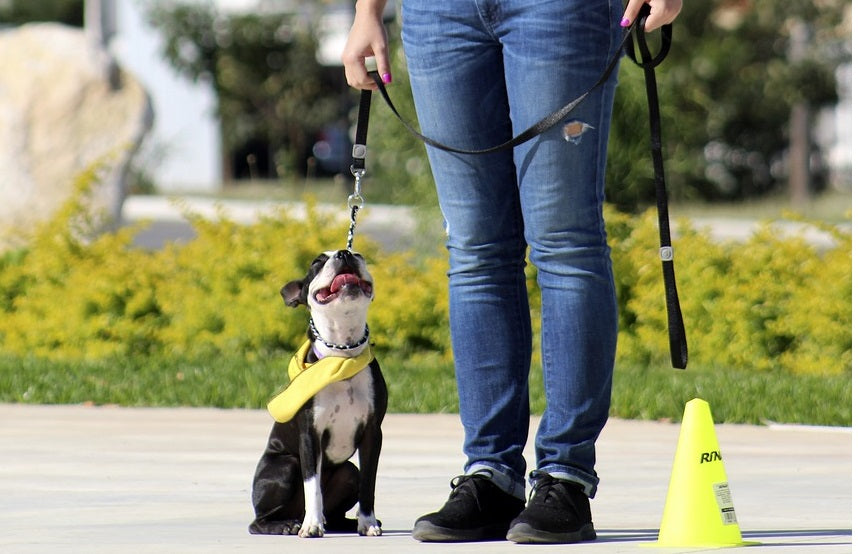
Why Dominance-Based Training is Bad
Share
Why Dominance Theory is Harmful in Dog Training: Understanding a Dog’s True Nature
The idea that we need to be “alpha” or dominant over our dogs has been around for decades, but modern science shows that this approach is not only outdated but can be detrimental to a dog’s well-being. Let's explore why dominance theory doesn’t hold up—and why it’s time to embrace a more compassionate, effective training approach based on trust and cooperation.
A Misunderstanding of Dog Behavior
Dominance theory suggests that dogs are constantly trying to “take over” and that owners need to assert control to keep them “in line.” This concept came from early studies on wolf behavior, which suggested that wolves live in strict hierarchical packs with “alpha” leaders. However, these studies have since been debunked. More recent research, like that published by David Mech, who originally introduced the “alpha” concept, reveals that wolves in natural environments operate as family units rather than hierarchies, with leaders more like parents than tyrants.
Dogs, while related to wolves, have evolved to live alongside humans, not in rigid packs. They are social creatures who rely on cooperative relationships rather than competition for dominance. Viewing their behavior through a dominance lens overlooks the complex ways they communicate and interact.
Imagine Living in Constant Conflict
Think about your relationships with friends or family. Imagine if every disagreement or misunderstanding was seen as a power struggle, with someone needing to “win” each time. It would likely create resentment, stress, and a breakdown in trust. For dogs, training rooted in dominance creates a similar experience. They may learn to avoid certain behaviors, but they do so out of fear, not understanding.
The Problem with Dominance-Based Training
Training based on dominance often involves forceful or confrontational techniques, like leash corrections, “alpha rolls,” or even scolding and intimidation. Studies have shown that these methods can lead to increased stress, anxiety, and even aggression in dogs. In a study published in Applied Animal Behaviour Science (Hiby, Rooney & Bradshaw, 2004), dogs trained with punishment-based and dominance-based methods displayed more behavioral issues, particularly aggression, compared to those trained with positive reinforcement.
When we approach training as a power struggle, we lose out on an opportunity to connect with our dogs. Instead of learning cues in a positive, stress-free environment, dogs may become anxious or fearful, making them more likely to react defensively. This creates a cycle where the dog’s response reinforces the idea that they need to be “controlled,” when in reality, they’re just responding to a stressful situation.
Dominance Theory Ignores the Root of the Problem
Imagine if every time you were upset or frustrated, someone responded by telling you to “suck it up” instead of understanding why you felt that way. Dominance-based methods focus on suppressing behaviors without addressing the underlying causes. For example, a dog barking at the mail carrier may not be trying to “assert dominance”—they may be scared or anxious about the arrival of a stranger.
By ignoring the root cause, dominance training fails to teach dogs appropriate responses or help them feel secure in new situations. Positive reinforcement, on the other hand, teaches dogs to associate new or challenging situations with good things, like treats or praise. When a dog barks at the mail carrier, for example, we can use rewards to teach them that calm behavior will earn them something they enjoy, like a treat or affection.
Building Trust Through Positive Reinforcement
Training is most effective when it’s a partnership, not a power struggle. Positive reinforcement focuses on teaching dogs what to do rather than what not to do, making learning a safe, enjoyable process. Studies, such as those published in Journal of Veterinary Behavior (Deldalle et al., 2014), show that reward-based methods are associated with higher engagement, faster learning, and lower stress levels in dogs.
Trust is the foundation of a good relationship with any animal. When we use positive reinforcement, we show our dogs that they’re safe with us, that we’re consistent and kind, and that they can rely on us for guidance.
Wrapping Up: It’s Time to Move Beyond Dominance
The dominance theory belongs to the past. As we learn more about dogs and their needs, we see that they aren’t trying to “take control”—they just want to feel safe, loved, and understood. By moving away from dominance-based methods and embracing positive reinforcement, we help our dogs become confident, happy companions who trust us as their partners.
When dogs are calm, they are happy and live their best lives. With reduced stress, they get sick less often and are more able to enjoy the little things in life. Like stretching out on the couch, or sniffing grass. To help support your dog in enjoying a calm life, we recommend AC for Dogs.
